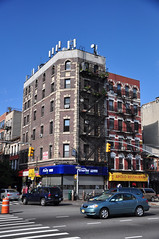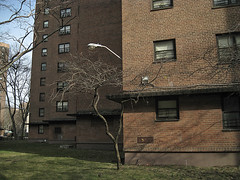New York Songlines: Delancey Street
with Kenmare Street
Lafayette | Centre | Mulberry | Mott | Elizabeth | The Bowery | Chrystie | Forsyth | Eldridge | Allen | Orchard | LudlowEssex | Norfolk | Suffolk | Clinton | Attorney | Ridge | Pitt | Columbia

Delancey Street was originally a lane that ran near the northern edge of the Delancey estate, one of the largest pieces of property on Manhattan, covering what are now some 120 blocks on the Lower East Side between Bowery and the East River. The Delanceys, a French Huguenot family that was perhaps the richest in pre-Revolution New York, took the king's side during the conflict and were forced into exile when their side lost. The estate was carved up by more patriotic land speculators.
Delancey Street was once a high-rent shopping district--though by 1922, when Lorenz Hart wrote, ''It's very fancy on old Delancey Street, you know,'' he may have been joking. Through much of the 20th Century, the street went through some hard times-- which is why rapper Dana Dane's 1987 hit ''Delancey Street'' is about being held up at gunpoint while shopping for clothes--but seems to be in a process of hipification.
Lucille Ball sang of being "Sally Sweet, the Queen of Delancey Street" in the song "Cuban Pete." Delancey Street appears under the name "Yancy Street" in the Marvel Universe, where it serves as the neighborhood where Ben Grimm, aka The Thing, grew up. The street is perhaps best known today for Crossing Delancey, a film about a Jewish woman finding love on the more authentically ethnic south side of the street.
Kenmare, the street's name west of the Bowery, is a village in Ireland's County Kerry, and the birthplace of the mother of Big Tim Sullivan, a local Tammany leader.


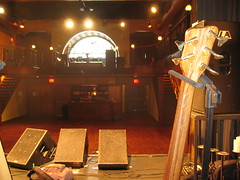

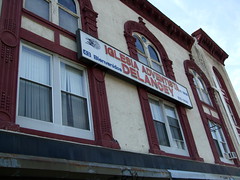
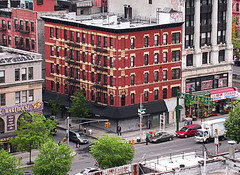
![Delancey - then and now by [phil h], on Flickr](http://farm3.static.flickr.com/2224/2220094543_de99860f55_m.jpg)
